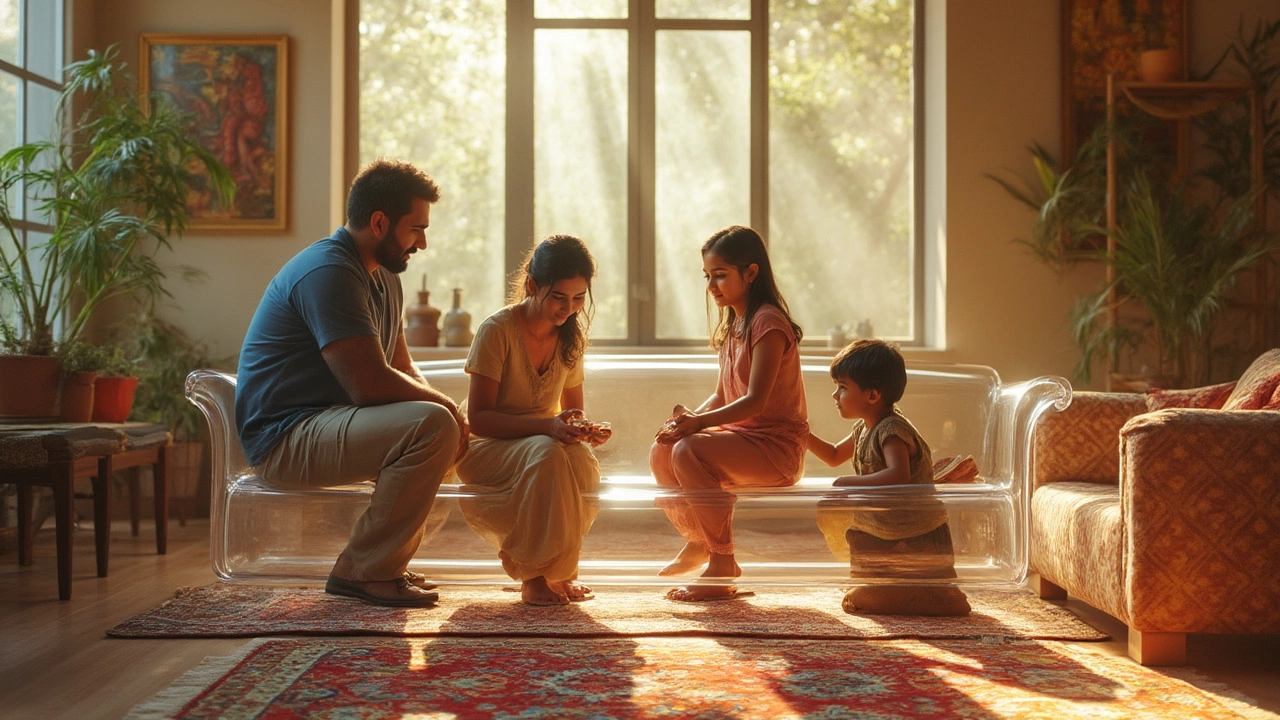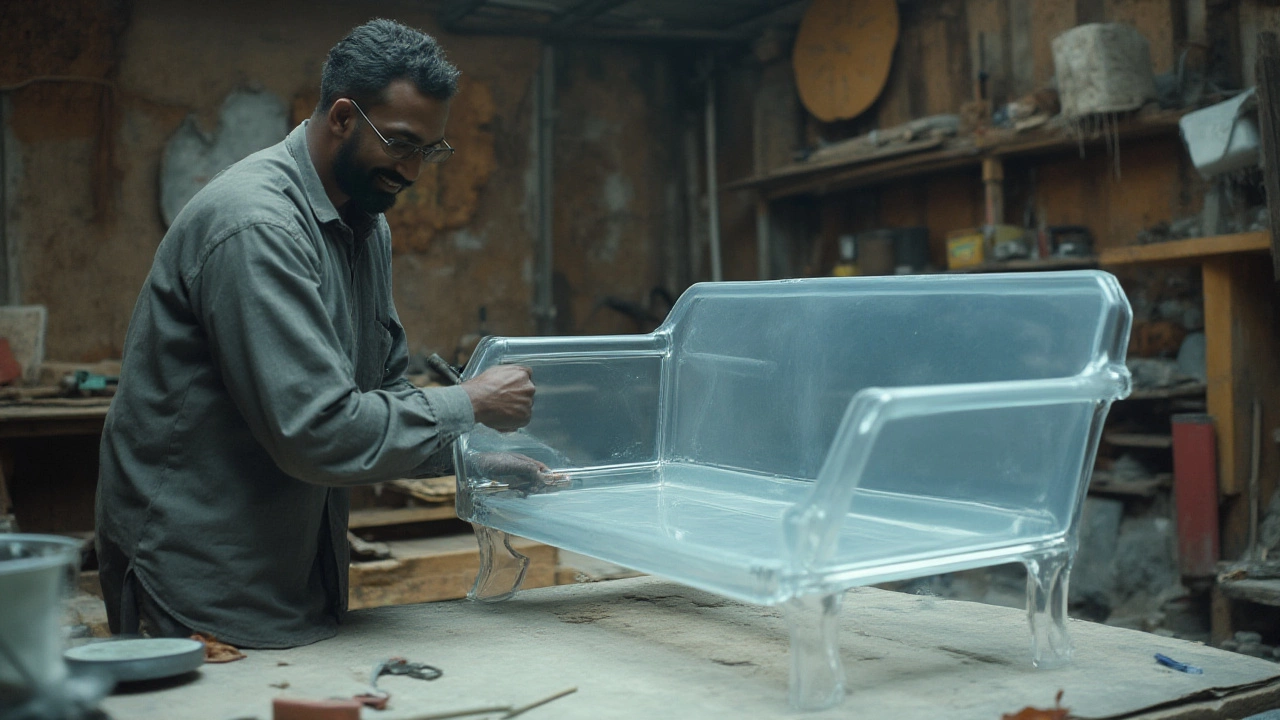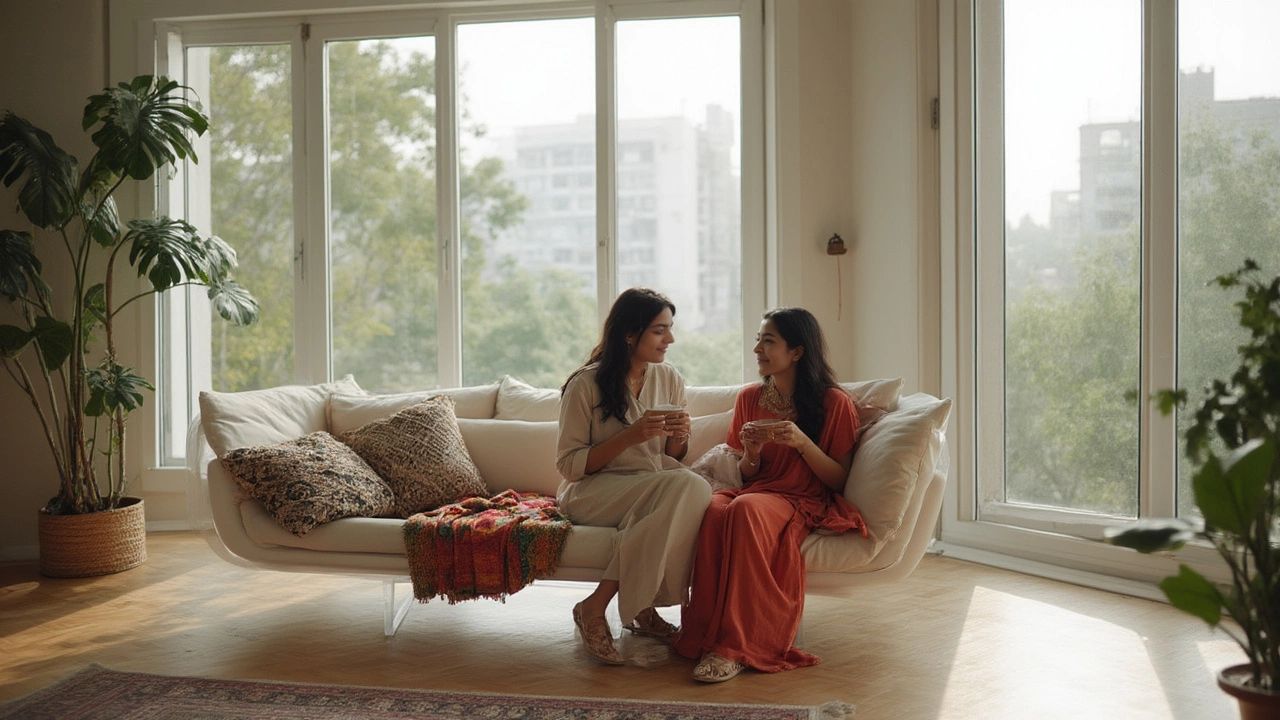Ghost Sofas Explained: The Trendy Transparent Couch for Modern Homes

Picture yourself sinking into a sofa—but the sofa seems to vanish under you, as if you’re lounging on thin air. That’s the weird, futuristic magic of the ghost sofa. Forget flowery prints and that big brown beast you threaten to replace every spring. There’s something about a see-through couch that stops people in their tracks. It’s disruptive. It’s different. It's a bit playful, and it draws every eye in the room without adding clutter. If you’re wondering whether this is just another design gimmick or the next “it” piece for contemporary living, you're not alone. The ghost sofa quietly blurs the line between furniture and modern art, and people can’t stop talking about it.
What Exactly Is a Ghost Sofa?
A ghost sofa is a transparent or semi-transparent couch, usually made from acrylic, Lucite, or polycarbonate. This isn’t a spirit haunting your living room—it’s a real, functional piece of furniture built to look almost invisible. Philippe Starck is the designer most closely linked with “ghost” furniture, having launched the iconic Ghost Chair in 2002. The trend caught on and ballooned into ghost tables, beds, and yes, sofas. While traditional sofas hog visual space, a ghost sofa almost disappears, giving small rooms an uncluttered vibe and helping modern spaces feel open and slick.
Manufacturers mould thick, durable sheets of plastic into ergonomic forms that echo classic sofa shapes, but without the heavy upholstery. They’ve become a go-to for design lovers who want to make a statement or keep their rooms open and light-filled. Some even come with subtle tints—smoky grey, faint blue, or frosted—adding just enough colour without losing that weightless illusion. Transparent furniture started gaining steam back in the '70s and '80s, but it took Instagram and Pinterest to boost ghost sofas to viral fame.
Why the term "ghost"? The sofa’s see-through design almost disappears when you look at it, making it blend into any style or colour scheme. The irony, though, is that ghost sofas still turn heads. It’s one thing to spot a Lucite chair at a hip café—another to see a plush-looking sofa in someone's lounge that barely looks there at all. Ghost sofas usually hit the market as statement pieces that play with light, reflections, and the boundary between visible and invisible. If you’re into minimalism, these are like catnip. If your living room is starved for daylight, a ghost sofa won’t block a ray.
The common sizes cover everything from compact loveseats perfect for small flats to sprawling transparent sectionals. Designs range from angular mid-century shapes to curvier, almost cloudlike forms. Some versions use a Lucite frame with traditional upholstered cushions for a halfway-there effect. Most, however, are all clear, all the way through. You’ll even find limited edition and art gallery versions fetching eye-watering prices, especially if designed or signed by a famous name.
So while the ghost sofa might not haunt your living room, it can certainly haunt your imagination. It’s the hush that draws a lingering second glance at every house party, family gathering, or virtual background on a video call. As show-stopping as it is subtle, this unique sofa brings both style and function into the 21st-century living space.
Why Are Ghost Sofas So Popular?
It’s easy to see why ghost sofas have become a favourite among interior designers and home decor fans. Their biggest sell? They don’t clutter up the sight lines in a room. If you live in a small city flat, you know every inch counts. Bulky, stuffed sofas swallow space and make rooms feel crowded, dingy, or dated. With a ghost sofa, the space feels almost magically bigger and lighter—even if you pile on the cushions. That lightness is especially handy for apartments in cities like Manchester, where grey weather can make rooms feel smaller.
The trend towards open-plan living has only boosted the ghost sofa’s popularity. People want spaces to flow, not get sliced up by chunky furniture. Transparent sofas let the eye travel from wall to wall, straight through the sofa, without interruption. For rooms with gorgeous flooring, an open fireplace, or a big window, ghost sofas stop nothing from shining. It’s a clever way of showing off your home’s best features without blocking the view. And if you’re the type who likes to change things up every season, you won’t have to worry about whether your new rug or wall paint matches your furniture—it always matches clear plastic.
The minimalist look hit the mainstream in the mid-2010s, but ghost sofas aren’t just for people who want everything white and empty. They can work in maximalist, boho, or even vintage-themed homes as a bit of visual relief, balancing bold or bright pieces with something simple yet stunning. Want to add colour without losing that modern edge? Throw on a couple of neon velvet pillows or a wild patterned blanket, and you suddenly have a high-impact corner with almost no effort.
When it comes to practicality, people also like that ghost sofas are surprisingly tough. The plastics used are the same as those in bulletproof glass and high-end aquariums. Lucite, for example, is 2-3 times stronger than glass, won’t yellow with age, and resists scratches fairly well. Spilled some wine after a long day? No drama—wipe it down, and you’re good. Even parents of messy kids or pet owners swear by them as low-maintenance and less likely to absorb funky smells or fur. The only real worry is scratching from sharp objects, but with a few smart precautions (using a throw or seat pads in busy homes), most people find them as hardy as upholstered alternatives.
Another big pull is the “wow” factor. Guests can’t help but comment the first time they see one. In a house full of ordinary furniture, a ghost sofa is a bit of design theatre—cool, clever, and unexpected. They also work for rented homes or offices because they're easy to clean, neutral, and suit pretty much any taste. No wonder they keep popping up in stylish Instagram posts, luxury hotel lobbies, and even TV show sets.

How Are Ghost Sofas Made?
Building a ghost sofa isn’t just a case of pouring plastic into a mould and popping out a couch. Every angle, curve, and join has to be engineered for both strength and comfort. Most ghost sofas start as thick sheets of acrylic or polycarbonate—think 20mm or more. These clear plastics are heated until soft, then carefully formed into shape using industrial presses. Every part of the sofa, from armrests to legs, must be bent and set with perfect timing, or the plastic will crack or turn cloudy. For complex designs, sometimes they glue or weld pieces together using clear adhesives that won’t show at the seams.
High-end models use a process called “thermoforming.” Engineers shape hot sheets over custom moulds, cooling each part to prevent warping. Some designers blend different plastics—Lucite for clarity, polycarbonate for strength—depending where the stress points are. If you want frosted or coloured finishes, they’ll mix pigments into the material during this process. After forming, the pieces are sanded, polished, and coated to resist scratches and static, giving that glasslike shine with none of the fragility.
Unlike regular sofas that are made in layers (wood frame, springs, foam, then fabric), ghost sofas tend to be assembled from just a handful of pieces. This cuts down on hidden weak spots and makes for easy cleaning. A few traditional touches might sneak in: chrome feet or bespoke cushions trimmed to float atop the see-through base. For more padded models, designers may set hard-to-see clear supports under foam pads, making them comfier without ruining that weightless look.
Surprisingly, some ghost sofas are handmade or at least hand-finished. The plastic needs to be worked with care and patience, especially on curves and joins. High-quality versions can take weeks to complete, and you can see why they’re pricier than your average sofa-in-a-box. Though mass-produced ghost sofas do exist, the best ones tend to come from boutique brands specialising in acrylic furniture.
Safety is also a concern. UK and EU laws require furniture to meet strict fire safety standards—including fire-resistant treatments on anything that could catch flame. Most ghost sofas won’t catch fire easily, but if you find a cheap import online, make sure it’s certified and meets the rules. Transparent plastics like Lucite can stand up to heat far better than most people think, but always double-check with suppliers if you plan on using them near fireplaces or radiators.
Ghost Sofa Pros, Cons, and Considerations
So, is a ghost sofa worth it for your flat, house, or studio? Let’s break it down.
- Pros: First up, ghost sofas are the ultimate space-makers. If you’re tight on square footage, nothing lightens a cramped lounge like invisible furniture. They’re sleek, timeless, and fit pretty much any décor scheme—modern, vintage, you name it.
- The only real “match” issue is with overly warm or orangey rooms; sometimes, a crystal-clear sofa will reflect those hues and look a bit odd, but that’s fixed with throws or cushions.
- They’re tough as old boots. Properly made Lucite sofas don’t shatter like glass, resist yellowing (even in sunlight), and can take more of a beating than most people expect.
- Cleanup is simple: a wipe with a microfibre cloth, a bit of water, and you’re sorted. No worrying about spills, pet fur, or dust gathering unseen in the corners.
- Ghost sofas have high resale value, especially the ones made by popular designers or limited-run models. That’s rare in the world of sofas, where used pieces usually fetch next to nothing.
- Cons: Not everything glows, though. Ghost sofas are notorious for fingerprint smudges, scratches, and occasional static cling. If you’ve got little ones or excitable pets, that’s something to remember. A rogue Lego brick or dog claw can scratch the surface, so some extra protection or a throw is smart.
- Comfort is a talking point. While you won’t sink into a ghost sofa the way you would with a stuffed Chesterfield, most are much better than you’d expect—especially models with clear foam pads or tailored cushions. Still, don’t expect super squishy seating unless you pick one of the half-upholstered versions.
- The up-front price can set you back. Designer ghost sofas with pure Lucite can cost anywhere from £800 to £5,000 depending on the size, brand, and rarity. High-quality replicas do exist, but avoid bargain-basement buys—they’re likely to discolour, crack or fail safety standards.
One last word: if you love rearranging your space or want your room to stay looking sharp for years, a ghost sofa holds up to both. Keep cleaning supplies for dusting handy (static in dry winter air attracts it), and avoid harsh abrasives that could dull the finish. Don’t overload the sofa either—weight ratings matter, especially for longer sectionals. Recent surveys show about 65% of buyers say their ghost sofa lasted as long as, or longer than, any other couch they’ve owned. For something so out-there, that’s not bad.

Fun Facts, Design Ideas, and More
You might be surprised by just how many homes secretly sport a ghost sofa—from celebrity lofts to high-end hotels. Kendall Jenner reportedly has a Lucite ghost coffee table paired with a transparent loveseat, and they crop up regularly in Elle Décor features. Ghost sofas also steal the show on film and TV, popping up in shows like “Succession” and being used to pull off those sleek boardroom looks.
Designers love to pair ghost sofas with textural opposites to ramp up the drama. Imagine a fluffy faux fur rug, heavy wool curtains, and a sofa you can almost see through. It’s a trick for instantly modernising heritage homes or making bachelor pads look more sophisticated. And for tiny studies or entryways, go for a mini version—they create “negative space,” giving your eyes a break amidst the chaos.
If you’re keen to buy, here’s a pro tip: always test the sofa in person if you can, or check return policies carefully. Photos can’t always tell you if a model feels sturdy or creaks when you sit. Look out for safety certificates, and buy from makers who offer proper guarantees. For DIY buffs, acrylic care kits are worth a punt—these keep scratches at bay and restore shine after years of use.
For the numbers folk, here's a handy table showing some quick stats from recent UK homeware survey reports:
| Feature | Typical Ghost Sofa | Traditional Sofa |
|---|---|---|
| Average Weight (2-seater) | 22kg | 43kg |
| Cleaning Time (weekly) | 3 minutes | 12 minutes |
| Resale Value (3 years) | 45% | 20% |
| Percentage reporting scratches | 60% | 15% |
So, if you’re after a piece that merges fashion, function, and a bit of interior wizardry, ghost sofas offer something traditional sofas just can’t. They can turn any space from cramped to open, and from ordinary to unforgettable—all while letting your own style take centre stage.